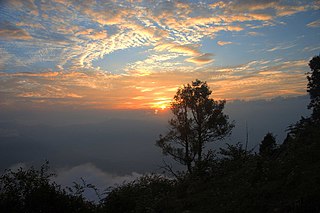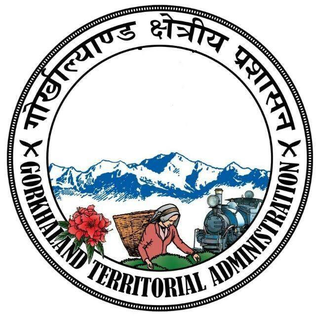
West Bengal is a state in the eastern portion of India. It is situated along the Bay of Bengal, along with a population of over 91 million inhabitants within an area of 88,752 km2 (34,267 sq mi). West Bengal is the fourth-most populous and thirteenth-largest state by area in India, as well as the eighth-most populous country subdivision of the world. As a part of the Bengal region of the Indian subcontinent, it borders Bangladesh in the east, and Nepal and Bhutan in the north. It also borders the Indian states of Odisha, Jharkhand, Bihar, Sikkim and Assam.

Darjeeling is a town and municipality in the northernmost region of the Indian state of West Bengal. Located in the Eastern Himalayas, it has an average elevation of 2,045 metres (6,709 ft). To the west of Darjeeling lies the easternmost province of Nepal, to the east the Kingdom of Bhutan, to the north the Indian state of Sikkim, and farther north the Tibet Autonomous Region region of China. Bangladesh lies to the south and southeast, and most of the state of West Bengal lies to the south and southwest, connected to the Darjeeling region by a narrow tract. Kangchenjunga, the world's third-highest mountain, rises to the north and is prominently visible on clear days.

Kalimpong is a town and a municipality in the Indian state of West Bengal. It is located at an average elevation of 1,250 metres (4,101 ft). The town is the headquarters of the Kalimpong district. The region comes under Gorkhaland Territorial Administration which is an autonomous governing body within the state of West Bengal. The Indian Army's 27 Mountain Division is located on the outskirts of the city.

Charles McFarlane Inglis FES, FZS was a naturalist and curator of the Darjeeling museum in India from 1923 to 1948. The museum was run by the Bengal Natural History Society and many of his writings were published in that society's journal which he started and edited.

Siliguri, pronounced [ˈʃiliɡuɽi](listen)) is a major city in West Bengal that forms "Twin Cities" with the neighboring district capital of Jalpaiguri. The city spans areas of the Darjeeling and Jalpaiguri districts in the Indian state of West Bengal. Known as the "Gateway of Northeast India", Siliguri is popular for three Ts - tea, timber and tourism. It is located on the banks of the Mahananda River and the Teesta River at the foothills of the Himalayas. Siliguri is the third largest urban agglomeration in West Bengal, after Kolkata and Asansol.

Bagdogra is a settlement in the Naxalbari CD block in the Siliguri subdivision of the Darjeeling district, in the Indian state of West Bengal. It is a part of the Greater Siliguri Metropolitan Area. The Bagdogra is well connected by air to six major cities of India – Delhi, Mumbai, Bengaluru, Hyderabad, Kolkata and Chennai through the Bagdogra Airport. The Bagdogra railway station is also well connected.

Darjeeling District is the northernmost district of the state of West Bengal in eastern India in the foothills of the Himalayas. The district is famous for its hill station and Darjeeling tea. Darjeeling is the district headquarters.

Darjeeling tea is a tea made from Camellia sinensis var. sinensis that is grown and processed in Darjeeling or Kalimpong Districts in West Bengal, India. Since 2004, the term Darjeeling tea has been a registered geographical indication referring to products produced on certain estates within Darjeeling and Kalimpong. The tea leaves are processed as black tea, though some estates have expanded their product offerings to include leaves suitable for making green, white and oolong teas.

Neora Valley National Park is a national park in Kalimpong district, West Bengal, India that was established in 1986. It spreads over an area of 88 km2 (34 sq mi), and is a rich biological zone in eastern India. It is the land of the red panda in the pristine undisturbed natural habitat with rugged inaccessible hilly terrain and rich diverse flora and fauna. It is linked to Pangolakha Wildlife Sanctuary of Pakyong District as well as forests of Samtse District, Bhutan via thick cover of forests.

The Himalayan keelback is a species of grass snake in the family Colubridae. The species is endemic to South Asia.
Lycodon gammiei, commonly known as Gammie's wolf snake, is a species of nonvenomous colubrid endemic to northern India.

The Gorkhaland movement is a campaign to create a separate state of India in the Gorkhaland region of West Bengal for the Nepali speaking Indians. The proposed state includes the hill regions of the Darjeeling district, Kalimpong district and Dooars regions that include Jalpaiguri, Alipurduar and parts of Coochbehar districts. A demand for a separate administrative unit in Darjeeling has existed since 1909, when the Hillmen's Association of Darjeeling submitted a memorandum to Minto-Morley Reforms demanding a separate administrative setup.

Geography of West Bengal, a state in eastern India, is diverse, of high peaks of Himalaya in the northern extremes to where Himalayas are in the north and sea is at the south, with both plains and plateaus covering the remaining region.

University of North Bengal is a public state collegiate major research university in North Bengal region of West Bengal, which is located in Raja Rammohanpur, Siliguri, Darjeeling district, in the Indian state of West Bengal. A second campus is in Danguajhar, Jalpaiguri in Jalpaiguri district and a third campus is in Salt Lake, Kolkata also in West Bengal. The university was established in 1962 to fill growing manpower needs in the six North Bengal districts and the neighbouring state of Sikkim. North Bengal University offers degrees in undergraduate, post-graduate taught-research, doctorate and post doctoral programs.

The climate of West Bengal is varied, with tropical savannah in the southern portions of the state, to humid subtropical areas in the north. Temperatures vary widely, and there are five distinct seasons. The area is vulnerable to heavy rainfall, monsoons, and cyclones. There are some mountains in the area which are generally cold all year round.

The Gorkhaland Territorial Administration is a semi-autonomous council for the Darjeeling and Kalimpong districts of West Bengal state in India. The GTA was formed in 2012 to replace the Darjeeling Gorkha Hill Council, which was formed in 1988 and administered the Darjeeling hills for 23 years.

West Bengal is a state in the eastern region of India and is the nation's fourth-most populous. The state capital is Kolkata. The state encompasses two broad natural regions: the Gangetic Plain in the south and the sub-Himalayan and Himalayan area in the north. The tourism in West Bengal is maintained by WBTDCL, a state government owned enterprise.

The Emblem of West Bengal is the official seal of the government of the state of West Bengal, India.
All India Darjeeling Gold Cup, also known as All India Brigade of Gorkha's Gold Cup Football Tournament, or simply GTA Chairman's Gold Cup, is an Indian association football tournament held in Darjeeling and organized by the Indian Darjeeling Gorkha Hills Sports Association (DGHSA). The tournament debuted in 1975. Apart from some top clubs from Calcutta Football League West Bengal, clubs from other Indian states also participated in the tournament.

















